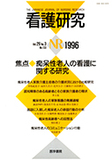Japanese
English
- 有料閲覧
- Abstract 文献概要
- 1ページ目 Look Inside
緒言
痴呆性老人の出現率は,65歳以上人口の6.8%に相当すると推計されているが,出現率は高齢になるほど高くなり,2000年には約160万人程度になると見込まれている(痴呆性老人対策に関する検討会報告,1993)。今日,国は高齢者保健福祉推進10か年戦略を策定し在宅ケアサービスの拡充目標を定めているが,痴呆性老人に対するサービスの拡充目標には特にふれられていない。最近の調査によれば,在宅痴呆性老人へのサービスは,全国自治体が在宅虚弱老人を対象に提供している総サービスの3分の1から4分の1に限られていた(芳賀ら,1994)。一方,痴呆性老人家族介護者が,在宅あるいは施設を選択する「その時」の決定は医学的特性よりも介護をとりまく内外の諸要因に規定されやすい(中島,1986;1987;1989)。この2つの点を考えても,今日の痴呆性老人の介護状況を明確にし,現在から未来への対応に備えることを急務としなければならない。
本研究の目的は,保健医療・福祉サービスが政策的にも専門的援助においても乏しかった1980年代の痴呆性老人の家族介護主担者と,痴呆性老人へのサービスが政策的課題として示された1990年代以降の家族介護主担者の介護状況の変化を比較し,その要因を明確にする中で,家族介護主担者が求めている援助の方向性を考究することである。
The purpose of this study is to clarify the changesof the caregivers'status with comparison of two cross-sectional studies. The subjects were 658 (primary, in 1982) and 705 (secondary, in 1991) group members of “The Association of Families Caring for Elderly Persons with Dementia”.
The summary of results are as follows:
1) The mean life span of a person suffering dementia was found to be longer in 1991 than 1992.
2) In 1991, about 30 percent of the patients in all age groups were hospitalized and about 70 percent of the patients were treated at home. These facts indicated that the medical facilities had expanded their capacities during the 9 year period for receiving the elderly with dementia.
3) Family members who wished to live independently supported the idea that care should be given by a decreased number of individuals within the family. In that sense, the family's power of caregiving was decreased.
4) The range of main caregivers' informal social-support network was remarkably expanded.
5) The more the service were expanded, the more the service were utilized by the caregivers. However, the quality and the quantity of theservices provided are still not sufficient to meet the caregivers' need.
6) In balance, the difficulties caregivers used to face, seemed to be decreased in 1991.

Copyright © 1996, Igaku-Shoin Ltd. All rights reserved.


